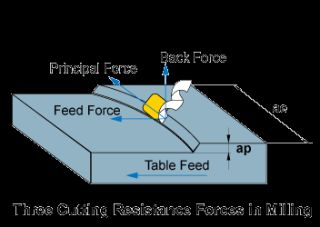By raoul.lector
Clarification about the cutting force
Hi, Is the cutting force (see Result frame) the sum of all the forces that the milling process applies to the tool ? I'd like to get some clarifications on what is included in the Cutting force. For example, the cutting force could be broken down into a principal force (parallel to the cutting movement), a feed force (parallel to the feed movement) and a back force (parallel to the tool axis). But, may be the cutting force is only equal to the feed force... Great application, your FSWizard On Line, go on ! Bye, Stéphane

Eldar Gerfanov (Admin)
Updated by: Eldar Gerfanov (Admin)November 28, 2013, 8:03 pm
Hello Stephane, In my app cutting force is calculated from material power constants. Which are measured in horse power per cubic inch of removed material. Then torque is calculted knowing RPM. Using torque and diameter i calculate cutting force. Which means cutting force is a product of all forces combined. This value is pretty accurate because it is measured experimentally. Now using lead angle, helix angle, rake angle etc you can find axial, and radial components. Its is easy to do, but i just do not see many people could need so much detail.
Gmack
This link says "When using an endmill with a high helix (above 50°) the material engages that helix and creates an axial force that tries to pull the tool out of the holder. The higher the helix angle the more axial force is created, and the possibility of pullout is increased." The implication is that there is no axial component unless more than one flute is engaged in the cut. Is that correct?
Eldar Gerfanov (Admin)